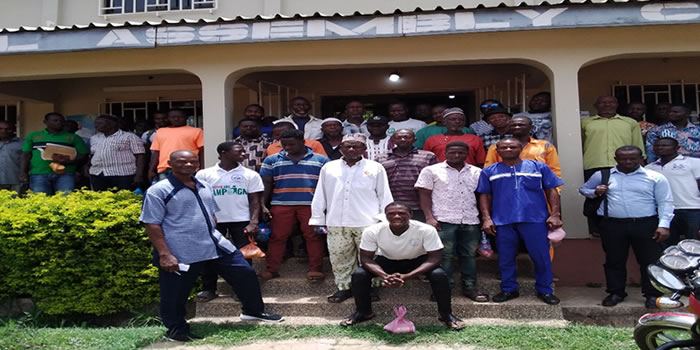Adverts
AGRICULTURE
Department of Food and Agriculture in Kintampo Municipal holds workshop on PFJ Phase II
Kintampo Municipal Department of Agriculture organized a day workshop to introduce phase two (2) of Planting for Food and Jobs (PFJ) or 2.0 one of the flagship programmes in our agriculture sector introduced by the President of the Republic of Ghana Nana Addo Dankwa Akufo Add in 2017.

Date Created : 4/22/2024 12:00:00 AM : Story Author : Rufina Yuoni/ Ghanadistricts.com
In a speech read by the Municipal Director for Agric Kintampo Mr. Simon Yambor stated that PFJ phase two also known as 2.0 has been introduced again by the government to correct the mistakes of phase one (1) and to modify some of the activities of the project.
He added that all participants should listen very careful and asked Questions from the phase one which they were not able to ask any time they watch the programme on televisions or listen to radio “for this flagship programmes being introduce by the government it is for the development of our districts and municipalities such as Kintampo and it is the taxes we pay that is been used to sponsor such programme for our benefit” he said.
The Municipal Coordinating Director for Kintampo Municipality Alhaji Inusah Yarifa in his address was very glad to see farmers in their numbers willing to know more about the phase two (2) of the PFJ is all about due to some questions asked by the farmers.
Mr. Inusah threw more light on the planting for food and jobs introduction and said, the part two is coming to current all the mistakes, dot all the ices and evaluate what went did not go on well in the phase one (1).
He advised all farmers at the programme to always try to buy into government policies and programmes to help them develop themselves for it is because of them that all programmes and policies are being introduced and following all the rules will give them benefit of getting good yields and products.
Mr. Kennedy Asirifi the Municipal Agric officer in charge of crops gave a brief power point presentation on the new introduction of the project PFJ Phase two or PFJ 2.0 with some details as its consist of it being a five years’ master plan for the renewal of Agriculture in Ghana (2024-2028), a holistic view of the value chain approach, the expected several critical challenges such as, availability and cost of financing, weak linkages among actors, unsustainable subsidy, unstructured markets for agricultural produce etc.
Mr. Asirifi touched on goals and objectives that is to ensure food availabilities, reduced food price inflation, promote import substitution, promote exports and so on, he also indicated that, PFJ or PFJ 2.0 programme will cover small, medium and large-scale farmers, input suppliers, agricultural extension agents, master AMSEC, agricultural mechanization services centers, warehouse infrastructure and collateral managers, produce off-takers, financial institutions, ancillary players/actors, and MoFA for coordination.
In conclusion, he pointed out the difference between PFJ 2.0 and PFJ 1.0 as to transform agriculture and stimulate growth through subsidies to food security and job creation, the phase aimed to transition from a direct input subsidy to direct credit system linked to a strutted market arrangement, no subsidy, and addition of other food crops.
The target crops of PFJ/2.0 are in; grains; maize, rice, soya beans and sorghum. Vegetables; tomatoes, pepper and onion. Root and tubers; cassava, yam and plantain. Poultry; broiler, layers and cockerel he also stated that every farmer in Ghana both companies and individuals are all qualified to benefit from the PFJ/2.0 project.
He ended giving the participants implementation modalities; beneficiary farmer registration and GPS farm mapping, farmers linked to accredited aggregators, aggregators provide timely inputs to beneficiary farmers on credit, participating banks provide payment guarantees to input suppliers on the program.
Aggregators recover the equivalent cost of inputs with produce, aggregators store the recovered commodities in designated warehouses, majority of the warehoused commodities would be sold to off-takers, and off-taker would pay the banks upon receipt of the warehouse commodities and so on.


 facebook
facebook X (twitter)
X (twitter) Youtube
Youtube +233 593 831 280
+233 593 831 280 0800 430 430
0800 430 430 GPS: GE-231-4383
GPS: GE-231-4383 info@ghanadistricts.com
info@ghanadistricts.com Box GP1044, Accra, Ghana
Box GP1044, Accra, Ghana